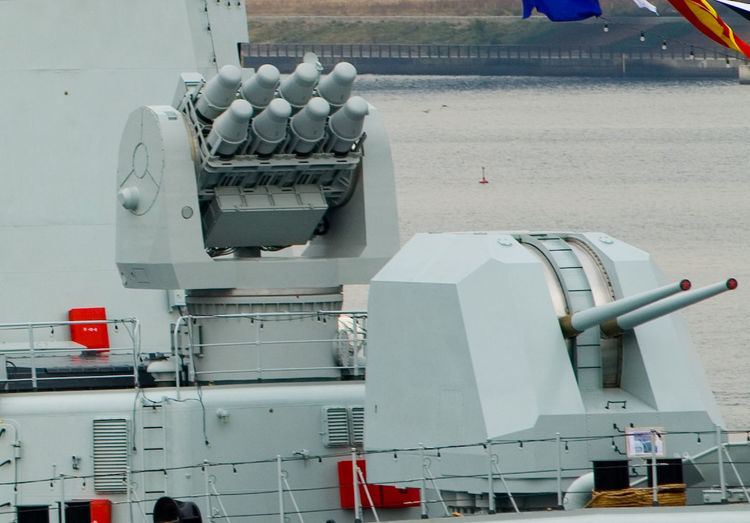 | ||
The HongQi (Red Flag/Banner) 7 or HQ-7 (FM-80) is a short-range air defense missile. The missile is deployed on both ships and land-based vehicles. China revealed the export version, FM-80, in the 1989 Dubai Aerospace Show. Unit cost is around $162,000 per launcher and $24,500 per missile.
Contents
History
In the late 1970s, China joined the Western powers in an informal alliance against the Soviet Union. At the time, China's military equipment was seriously lagging behind the Soviets in quality, and Beijing sought Western assistance to modernize its military. Countries such as the United States, UK, Israel, Italy, France, Germany and Australia responded by providing China with military sales and technological know-how transference, either openly or covertly.
China imported some land and sea versions of the Thomson-CSF Crotale missile in 1978-1979 for evaluation. The Thomson-CSF R-440 Sea Crotale surface-to-air missile (SAM) and Thomson-CSF TSR 3004 Sea Tiger E/F-band radar were installed on the Peoples Liberation Army Navy (PLAN) Type 051 destroyer Kaifeng (109) and Type 052 destroyer Harbin (112). The Peoples Liberation Army (PLA) found the Crotale system to be superior to the HQ-61 SAM, and instructed the 2nd Aerospace Academy (now the China Academy of Defense Technology) to reverse-engineer the Crotale, the 23rd Institute to reverse-engineer the radar and fire control system, and the 206th Institute to develop ground-based vehicle carriers for the SAM.
China was able to produce copies of the Crotale (HQ-7) missile for testing in 1983. It was certified for serial production in 1986-1988. China promoted an export version, FM-80, at the 1989 Dubai Aerospace Show. Through the 1990s, the HQ-7 was deployed at Peoples Liberation Army Air Force (PLAAF) bases, on PLA vehicles, and PLAN ships. It was PLAN's standard ship-based air-defense SAM for over a decade, until the introduction of the more capable, longer-range HQ-9.
HQ-7 (FM-80) Land-based
The HQ-7 SAM is used by PLA and PLAAF for short-range air-defense. At some PLAAF bases, the HQ-7 is deployed in hardened shelters. The PLA has mounted the HQ-7 on towed trailers.
A typical land-based HQ-7 battalion consists of:
Each Operational Section consists of:
Each Support/Maintenance Section consists of:
HQ-7 (FM-80) Self-Propelled
The 206th Institute has developed a 4x4 self-propelled version of the HQ-7. 4 x HQ-7 SAMs and a tracking radar system is mounted on a 4x4 vehicle, or towed vehicle.
HQ-7 (FM-80) Naval
The HQ-7 became PLAN's standard short-range air-defense SAM in the 1990s. Even the latest Type 054 frigate uses the Naval version of HQ-7. The typical configuration is one 8-cell launcher, with stores of reload missiles in multiples of 8 (8, 16, 24). Earlier versions required manual re-loading, while the latest have an auto re-loader that can be retracted under the deck.
The Naval HQ-7 uses a Type 360S E/F-band Doppler radar with a detection range of 18.4 km, connected to the ZJK-4 (Thomson-CSF TAVITAC) combat management system. The system is capable of processing up to 30 targets, and tracking 12 targets simultaneously.
HQ-7A (FM-90)
In 1998, the China National Precision Machinery Import and Export Corporation (CNPMIEC) produced an improved HQ-7 with faster and longer-range missiles, with an IR-tracking camera. This version received the export designation FM-90.
